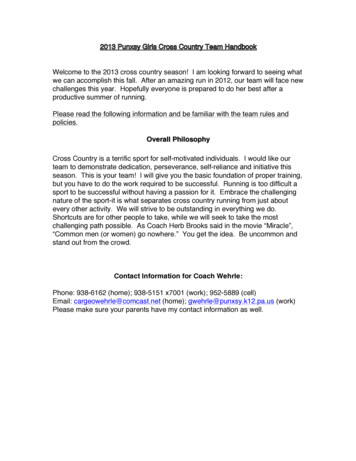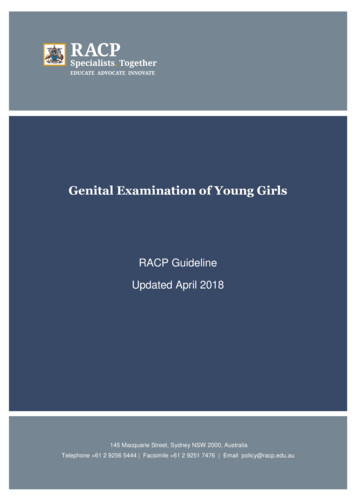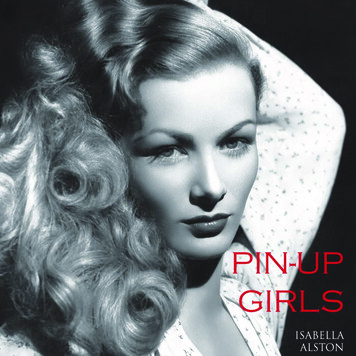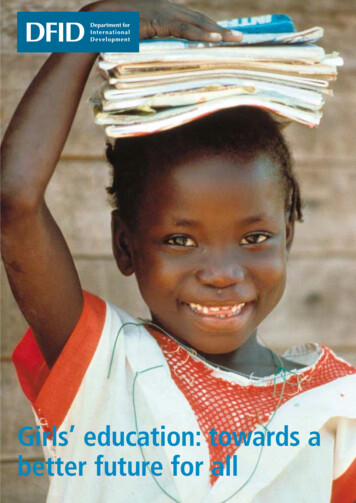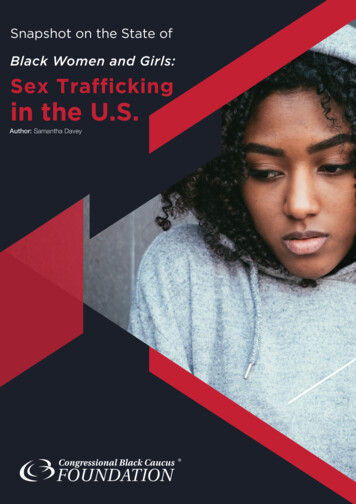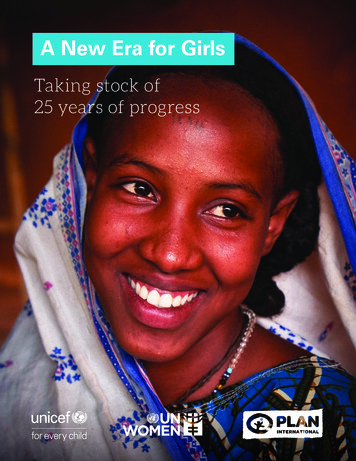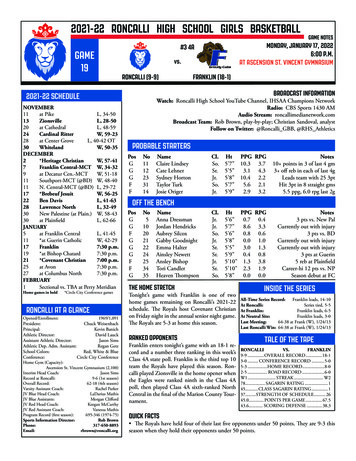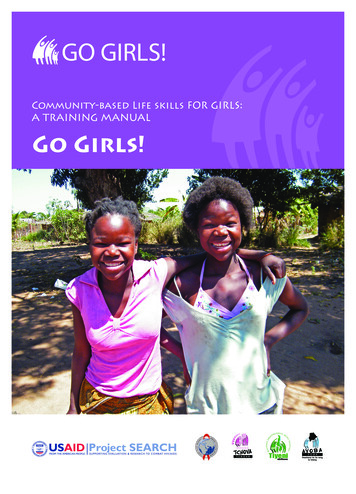
Transcription
GO GIRLS!GoGirls English.indd 14/25/2011 3:20:15 PM
GoGirls English.indd 24/25/2011 3:20:15 PM
This Go Girls! Community-based Life Skills for Girls Training Manual was made possible by thegenerous support of the American people through the President’s Emergency Plan for AIDSRelief (PEPFAR) and the U.S. Agency for International Development (USAID) under the terms ofContract No. GHH-I-00-07-00032-00, USAID Project SEARCH, Task Order 01. The contents are theresponsibility of the Go Girls! Initiative and do not necessarily reflect the views of PEPFAR or theUnited States Government.Suggested citation:Johns Hopkins Bloomberg School of Public Health/Center for Communication Programs (2011).Go Girls! Community-based Life Skills for Girls: A Training Manual. Baltimore, Maryland. Developedunder the terms of USAID Contract No. GHH-1-00-07-00032-00, Project SEARCH, Task Order 01.3GoGirls English.indd 34/25/2011 3:20:15 PM
4GoGirls English.indd 44/25/2011 3:20:16 PM
Table of ContentsIntroduction.7Icon Key. 15Session 1: Go Girls!: What to Expect?. 16Session 2: His and Hers. 20Session 3: Stay in School/Return to School. 24Session 4: Speak Up! Communicating With Others. 27Facilitator’s Reference 1: Examples of Strong, Weak and Aggressive Communication. 31Session 5: Making Good Decisions. 32Session 6: Healthy Friendships. 35Session 7: How to Communicate with Adults. 38Session 8: My Body Is Changing – Am I Normal?. 41Handout 1: Physical Changes During Puberty. 44Session 9: How Does Pregnancy Happen, Anyway?. 46Handout 2: Female and Male Reproductive Systems. 48Session 10: How to Communicate with a Partner. 53Session 11: Preventing Unintended Pregnancy. 57Handout 3: How to use a Condom. 61Session 12: STI/HIV Grab Bag. 62Facilitators Reference 2: Grab Bag Items and Their Connection to STIs/HIV. 65Session 13: Preventing Unwanted Advances. 68Session 14: Values, Money and Gifts. 72Session 15: Planning My Goal. 76Go Girls! Monitoring Forms. 795GoGirls English.indd 54/25/2011 3:20:16 PM
6GoGirls English.indd 64/25/2011 3:20:16 PM
AcknowledgmentsThis manual was written by Maryce Ramsey and Judy Palmore. Technical input was provided byJoanna Skinner, Patricia Poppe, Jane Brown, Carol Underwood, Jessica Fehringer, Tinaye Mmusi,Maipelo Madibela, Assana Magombo, Dorothy Nyasulu, Enni Panizzo and members of the PEPFARGender Technical Working Group and PEPFAR Botswana, Malawi and Mozambique countryteams.We would like to acknowledge several organizations whose materials have been adapted or usedin this manual. They are:International HIV/AIDS Alliance, www.aidsalliance.org Sexuality and Life-Skills: Participatory Activities on Sexual and Reproductive Health with YoungPeople. Our Future: Sexuality and Life Skills Education for Young People, Grades 6-7. Our Future: Sexuality and Life Skills Education for Young People, Grades 8-9.United States Agency for International Development, www.usaid.gov Doorways I: Student Training Manual on School-Related Gender-Based Violence Prevention andResponse, February 2006.Family Care International, Inc., www.familycareintl.org Pictures on male and female reproductive systems, menstrual process and pregnancy fromHealthy Women, Healthy Mothers: An Information Guide. 1995, 2nd Ed., Arkutu, A.EngenderHealth, www.engenderhealth.org Male reproductive system text adapted from Introduction to Men’s Reproductive HealthServices—Revised Edition: Participant Handbook. 2008. New York.PATH, www.path.org, Population Council, www.popcouncil.org, and Kenya AdolescentReproductive Health Project (KARHP) Female reproductive system, pregnancy, and menstruation text adapted from Tuko Pamoja:Adolescent Reproductive Health and Life Skills Curriculum. 2006.7GoGirls English.indd 74/25/2011 3:20:16 PM
8GoGirls English.indd 84/25/2011 3:20:16 PM
IntroductionThis Go Girls! Community-based Life Skills for Girls Training Manual has been developed to providea safe and fun learning experience where girls can be equipped with life skills and knowledge tohelp maintain a happy and healthy life, stay in or return to school and feel empowered to protectthemselves from HIV/AIDS. This manual has been designed specifically for girls ages 13 - 17, whoare not enrolled in school or live in very vulnerable situations.Background on the Go Girls!The Go Girls! Community-based Life Skills for Girls Training Manual was developed through theGo Girls! Initiative. The Go Girls! Initiative, funded by the U.S. Agency for International Developmentthrough the U.S. President’s Emergency Plan for AIDS Relief, was a three-year project (2007-2010)that aimed to reduce HIV prevalence among vulnerable adolescent girls aged 10-17 in Botswana,Malawi and Mozambique. Implemented by the Johns Hopkins Bloomberg School of Public Health/Center for Communication Programs (CCP), Go Girls! strived to strengthen gender programmingworldwide by developing new and expanding existing approaches to reduce adolescent girls’ riskof HIV infection. To share the Initiative’s results globally, a toolkit of key materials—including aninnovative tool for measuring girls’ vulnerability and a comprehensive set of program materials,including this manual—a toolkit is available as a free resource to help policy-makers andprogrammers promote strong girls and strong communities worldwide. To access the full set ofGo Girls! resources, visit http://www.k4health.org or http://www.aidstar-one.com or contact theU.S. Agency for International Development at GHCommunicationsTeam@usaid.gov.Why promote strong girls and strong communities?The goal of Go Girls! is to enable positive individual and collective action to live healthylives. Girls and their communities identified the phrase“strong girls”with empowermentto take action, to be able to resist insults and abuse and to pursue one’s dreams.“Strongcommunities” was thought to refer to the power of working together. Communitiesfound “strong girls, strong communities” a unifying and inspiring theme.Why focus on girls instead of boys?The Go Girls! Community-based Life Skills for Girls Training Manual recognizes that boys, girls,men and women are all vulnerable to HIV/AIDS. However, evidence shows that girls and youngwomen are the most vulnerable to HIV. For example: Girls have less opportunity to attend school or continue their education.Girls have less access to information about HIV/AIDS.Girls have less access to economic opportunities than boys, which may lead them to exchangesex for money.Traditional roles can discourage girls from being assertive.Many girls get married and start having sex at an earlier age than boys.Girls are more likely to be victims of sexual violence than boys.9GoGirls English.indd 94/25/2011 3:20:16 PM
Many HIV prevention programs do not address these and other factors that make girls morevulnerable to HIV/AIDS and they may not make special efforts to get girls involved. Go Girls! hopedto change this. Therefore, it focused on meeting adolescent girls’ needs.Definition of girls’ vulnerability to HIVGirls who are “vulnerable” to HIV are at greater risk of getting HIV than other girls. Thegirls most vulnerable to HIV are those who are orphans, early school leavers, sociallymarginalized, migrants, and/or who live in impoverished conditions. These factors,together with traits, such as knowledge, self-efficacy, alcohol consumption, socialinfluence, and weak relationships with parents or guardians often overlap to placegirls at higher risk of being infected with HIV.Using the Go Girls! ToolkitThe Go Girls! Toolkit is designed to support a comprehensive program that aims to reduce girls’vulnerability to HIV/AIDS by reaching out to communities, schools, parents and young girls; the programutilizes participatory awareness raising, community action items and skills building tools.The tools havebeen pilot tested in the three implementation countries – Malawi, Mozambique and Botswana—andrevised based upon the feedback from the facilitators and participants in each of the three countries.The five Go Girls! step-by-step training manuals are as follows: Go Girls! Community-based Life Skills for Girls: A Training Manual – This manual has beendesigned to strengthen life skills of girls ages 13-17, who are not enrolled in school or are invulnerable situations.Go School Girls! School-based Life Skills for Girls and Boys: A Teacher’s Manual – Thismanual helps teachers teach students a range of life skills that will help the students protectthemselves from HIV/AIDS.Go Teachers! Creating a Safe and Supportive Environment for Girls at School: A TrainingManual for School Personnel and Teachers – This manual helps school personnel understandand strengthen their roles as protectors of vulnerable girls and agents of change in their schoolsby promoting gender equitable teaching practices and addressing harmful school practicesthat put girls at risk of HIV infection.Go Families! Building Adults’ Skills to Communicate with Young People: A Training Manual– This manual helps parents, caregivers, and other concerned adults to better communicatewith the young people in their lives. The program aims to strengthen adults’ communication,role-modeling, and relationship skills with youth.Go Communities! A Manual for Mobilizing Communities to Take Action to Reduce Girls’Vulnerability to HIV/AIDS – This manual is a step-by-step guide to strengthen the skills ofMobilizers and Community Facilitators to engage communities to address and reduce girls’vulnerability to HIV/AIDS.The Toolkit includes two additional documents: 1) Strengthening Economic Opportunities forVulnerable Girls and Their Families and 2) Improving Community Support for VulnerableGirls through Radio.10GoGirls English.indd 104/25/2011 3:20:16 PM
This comprehensive Go Girls! Toolkit is designed to combat the multiple issues that make girlsvulnerable to HIV and thus it is intended that all the program components are implemented as apackage. However, if program funds do not allow implementation of the full package of materials,the program components can also be implemented independently.Using This ManualGo Girls! Community-based Life Skills for Girls Training Manual has fourteen (14) sessions.Each session is outlined as follows: Session title and description.Learning objectives.Estimated time.Materials.Facilitator preparation.Activities with step-by-step instructions.Session wrap-up with a practice activity to be done at home before the next session.Materials, information and resources needed1. Markers and flipchart OR chalk and chalkboard are needed for most sessions. When thesematerials are not available adapt the session accordingly.2. Handouts are needed for some sessions. These handouts are attached to the end of the sessiondesign. If you cannot make copies enough for all participants, try to at least have a few copiesthat you can pass around for participants to share.3. The Go Girls! Visual Briefs may be helpful for a facilitator and should be on hand for reference.4. Before the workshop, the facilitator will need to have on hand referral information for: Contraception. HIV testing and counselling. Preventing mother-to-child transmission of HIV. Psychosocial counselling referral for any vulnerable girls who have been abused orraped.5. Invite Health Center workers and/or NGOs working in the field of RH, FP and HIV to become“guest” facilitators to support Sessions 9, 11 and 12.What if people want to be paid for their time?The recruiters for the program should make it clear that participants will not receive money whenparticipating, although transport costs may be covered if your organization has the necessaryresources. During the first session the facilitator will remind participants that their involvementin this program is voluntary and they will not be paid. However, participants will gain many nonmonetary benefits from the program by building skills.Know your audienceDepending on the group you are working with, you may need to change your approach to leadingthe sessions. For example, out-of-school youth may have lower literacy skills than in-school youth.11GoGirls English.indd 114/25/2011 3:20:16 PM
For lower literacy groups you may want to draw more pictures and use more symbols whenwriting on the flipchart or chalkboard. You should also use simple language. Be sure that theinstructions are clear before starting any activity. Do not ask more than 2-3 questions at the endof each activity.Group sizeIdeal group size is 15-20 girls or fewer. Go Girls! utilizes participatory methodologies and encouragesdiscussion. By keeping the group size small, all participants will have a chance to actively engagein the program and facilitators will be better able to keep to the hour and a half session time.Be prepared for challengesEvery training experience has the potential to bring challenges. The best way to prevent challengesis to be prepared. Know the material and practice facilitating the activities with a friend or anotherfacilitator.Assess time neededSessions in this guide are designed for 1 hour 30 minutes but may run shorter or longer dependingon facilitation and discussion. Sessions were designed for this time length and ideally should bedelivered in whole.Facilitate the sessions in orderSessions were designed to complement and build on the content covered in prior sessions, so it isbest to facilitate sessions in order from Session 1 to Session 14.The Participatory Go Girls! Learning ApproachWhat I hear, I forget.What I see, I remember.What I do, I understand.This manual uses participatory teaching methods such as group discussion, brainstorming,role-play, small group work, educational games and storytelling. Participants will have manyopportunities to practice using new skills (e.g., communication and decision-making).The advantages of active participatory methods include: Improved critical thinking skills.Participants are more likely to remember and share new information.Increased motivation.Improved interpersonal skills.12GoGirls English.indd 124/25/2011 3:20:16 PM
Participatory MethodsBrainstorming: A brainstorm is an exploration of ideas and is a great way to open a topic fordiscussion. During brainstorming, no one should judge or place a value on an answer someonegives. Each answer is simply recorded on newsprint or a chalkboard or whatever is available forthe entire group to see. This activity encourages participants to expand their thinking about anidea and look at a topic from different angles and perspectives.Group discussion: Group discussion brings out responses from participants on a particulartopic, and provides opportunities for the facilitator to increase participant knowledge or correctmisinformation. The effectiveness of the group discussion often depends on a facilitator’s abilityto use open-ended questions, which are questions asked by the facilitator that need more than asimple “yes” or “no” answer. These questions help to bring out feelings or thoughts about a topicor an activity.1. “What did you learn from this activity?” is an open-ended question. “Tell me how this activityaffected you?” is another example of an open-ended question. Open ended questions oftenstart with What, When, Why or How.2. “Did you learn anything?” is not an open-ended question, because the participant can simplysay yes or no.Role-play: Role-play provides the participants an opportunity to experience a real-life situation,without having to take real-life risks. It is important that facilitators encourage participants to roleplay realistic situations, and not ideal situations.The rules of role-play are:1.2.3.4.5.Discuss the situation as a group.Agree on a storyline.Agree on who does what involving everyone.Rehearse.Act out for the group.Icebreakers: Before or during each session, facilitators may want to lead participants in anicebreaker to help them relax, have fun and reconnect with each other. Participants themselvesoften have great ideas for warm-ups and icebreakers. You can ask one or two participants eachsession to be responsible for a short warm-up activity and to keep the group energized throughoutthe sessions.A few examples of warm-up activities are:1. Who is the leader?Participants stand or sit in a circle. One person volunteers to leave the room.After they leave, the rest of the group chooses a leader.The leader is part of the circle and will perform a series of actions (such as clapping, tapping afoot or making a face) that will be copied by the whole group.The volunteer is called back in the room and invited to stand or sit in the middle of the circle.13GoGirls English.indd 134/25/2011 3:20:16 PM
2. The volunteer is tasked with the job of trying to guess who the leader is.The group protects the leader by not looking at her or making it obvious that they are followingher actions.When the volunteer correctly guesses the leader (may take several guesses) the volunteerbecomes part of the group and the leader is the new volunteer.Repeat while the fun lasts.Mime a lieAsk participants to stand in a circle.The leader starts by miming an action.When the person to the leader’s right asks “What are you doing?” the leader replies that she isdoing something completely different. For example, the leader mimes swimming and says “Iam washing my hair”.The person to the leader’s right then has to mime what the leader SAID that they were doing(e.g., washing their hair). The person to their right asks “What are you doing?” and they say theyare doing something completely different.Go around the circle in this way until everyone has had a turn.3. Making rain Ask participants to form a circle. Ask participants to follow the motions of the leader. Tell them that each person will follow thatmotion as you go around a circle clockwise. (The motions are: put palms together and rubhands together back and forth; click fingers; use hands to slap the tops of the thighs; stompfeet) Remind participants to begin the new motion after the person to their right has begun. The leader starts by putting palms together and rubbing hands together back and forth.The leader should continue the motion until every person in the circle is doing it. Once thishappens, the leaders should initiate the next motion. Continuous motion will produce a soundlike a thunderstorm. Repeat the cycle a few times. Once the leader has decided the energizer should end, she will just place her hands at her sides.This motion should travel around the circle, just as the other motions did, and allow silence.4. Skills Needed and Tips for Facilitating Go Girls! SessionsThe facilitator should preferably be female and have: Some previous training in participatory teaching methods.Understanding of gender terms (e.g., gender, gender roles) and gender issues. 1The ability to recognize his/her own values regarding young people; it is important thatfacilitators work with young people where they are and as they are, not where or who thefacilitator thinks they should be.1 Gender - socially constructed roles, responsibilities and behaviors. These roles are cultural, learned, change over time and vary within and between cultures.Gender roles or expectations – expectations that boys and girls (and men and women) are expected to act a certain way because they are male or female.Gender issues – In this manual, the term gender issues relates to expectations of how boys or girls ‘should’ act in society that can keep girls from reachingfull potential. Some examples are early marriage for girls, high rates of school dropout for girls, lack of discussion about sexual issues with girls, etc.14GoGirls English.indd 144/25/2011 3:20:16 PM
Tips for facilitatorsBelow are some tips and methods to help build your capacity as a facilitator.A good facilitator: Sees the participants as experts with information and skills to share, rather than seeingthemselves as the only experts in the room. Encourages participants to learn from each other, and thinks of him/herself as guiding theprocess rather than thinking of the pupils as empty bowls coming quietly to be filled withknowledge from the trainer. Believes we learn by doing, experiencing, practicing and feeling, rather than by memorizing,repeating, recording information. Is organized but flexible in changing methods based on participant need. Is enthusiastic about the topic and participants. Keeps promises to the group – to let participants speak, take a break, etc. Is patient and a good listener. Can deal with emotions if necessary.Reminders for the facilitator: Read the entire manual before beginning the training. Know all of the sessions before delivering the sessions and have materials preparedbeforehand. Adapt the activities and group discussions to make the sessions more appropriate to theage and education level of your particular group of pupils. Think about and plan for any issues that might arise during more “difficult” sessions. Provide local examples and make the activities relevant to the participants’ daily lives andconcerns. When possible, work from easy to difficult subjects. Have a “parking lot” for issues that arise during a session, but that are not relevant to the sessionobjectives. You can come back to them at another time or simply explain at the end of thetraining that it was important, but outside of the topic of the training. Capture important points on flip chart paper during discussions for use during the summaryactivities. It can be very challenging to both lead and write down all important points, soconsider having someone assist you to capture key points. End sessions on a positive note, with a clear take-away message. When appropriate, identifynext steps or possible solutions to the problem. Check to make sure you are not speaking more than the participants. If you find that youare doing most of the talking, encourage participants to answer each other’s questions, forexample if someone asks a question, open discussion to the participants with the inquiry,“Does anyone have an answer to that question?” The way you hold your body will help effectively facilitate the group. For example, lookingattentively and nodding makes them feel their contribution is important. Looking away caneffectively tell the person not to talk or participate. Always face the person to whom you arespeaking. Have fun!15GoGirls English.indd 154/25/2011 3:20:17 PM
Talking about Sexual IssuesMany of the issues raised in this manual are linked to sex, relationships and HIV which require thefacilitator and participants to discuss sensitive issues. Some facilitators may feel that by talkingabout sex and contraception with young people they are encouraging young people to have sex.Research shows that, on the contrary, talking with adolescents about these topics and giving themthe facts and consequences encourages them to delay sex and to consider abstinence. However,facilitators should not assume the participants are not having sex.Some tips for letting the participants know you are at ease talking about these issues: Accept the slang terms. But don’t be afraid to ask what they mean if you don’t know.Say you don’t know, if you don’t. But tell them you will come back with an answer to theirquestions; talk to a health care provider or other expert who can give you the correct answerand report back.Be nonjudgmental. Stick to the facts and do not share your own opinions and values.Do not answer personal questions about your own sexual experience. If the question comesup, let participants know that your role as a facilitator is not to discuss your own experience.Be comfortable. Thoroughly review these materials and discuss them with other facilitatorsin your organization so that you will be at ease when discussing these matters with theparticipants.Handling EmotionParticipants may get emotional during the workshop. Facilitators need to react sensitively andeffectively when a participant becomes visibly upset during a session so that she feels safe andnot embarrassed and so that the group can move past any awkwardness or discomfort. Someways for a facilitator to deal with an emotional situation are: moving the discussion away from anupsetting topic, relating an anecdote, moving on to a new topic, or taking a break.Participants may get upset by some of the topics in the workshop. They may have doubts aboutthemselves or may feel uncomfortable talking about issues related to sex with other adolescents.The discussion activities may remind them of their own uncomfortable situations they’ve been inbefore the workshop, at home or at school.If a participant is upset by an activity, a facilitator should try to talk to the participant in private tofind out why the person is uncomfortable and why. The facilitator may suggest that the participantstep out of the workshop space. The facilitator should not force the upset adolescent to talk aboutwhat’s upsetting her. Listen to what the participant is saying. Your role is to provide her withunderstanding, support and assistance. Do not attempt to tell the participant how she feels orhow you think she should feel. Assure her that it is ok and normal to feel upset. Please note: youshould be prepared to provide a participant who has been abused with contact information forpsychosocial counselling. You should have this information on hand before the first session.16GoGirls English.indd 164/25/2011 3:20:17 PM
Icon KeyThroughout this Manual, a few icons will appear to help you navigate the different forms ofinformation:Time of Session or ActivityMaterials NeededNote to FacilitatorHandout or Facilitator Resource Page17GoGirls English.indd 174/25/2011 3:20:17 PM
Session 1:Go Girls! What to Expect?Session OverviewSession Description: The facilitator explains the purpose of the Go Girls! program. Participantscreate a list of ground rules and take a pretest. The facilitator guides theparticipants through a structured goal-setting activity to help participantsconsider their own goals.Learning Objectives: By the end of this session participants will be able to:1. Explain the Go Girls! goal.2. Establish personal expectations for the Go Girls!3. State a personal goal.Time:1 hour 30 minutesMaterials: Chalkboard/chalk or flipchart/marker.Talking stick (a cane, stick or rolled up piece of paper). Write the Go Girls! program goal on chalkboard/flipchart paper. (See below)Make or bring in a talking stick (a cane, stick, or rolled up piece ofpaper). See Activity 1.FacilitatorPreparation:Activity 1: Getting Started20 minutes1. Welcome the participants.2. Ask participants to divide into pairs. Ask each participant to act as a reporter and ask herpartner the following questions: What is your name?What is something you like to do?What do you hope to get out of participation in these meetings?3. After every participant has had an opportunity to interview and be interviewed, ask participantsto sit in the circle. Each participant should introduce their partner, what they like to do andwhat they hope to get out of the meeting.4. As they are sharing, record what the girls hope to get out of the workshop on the chalkboardor flipchart paper.18GoGirls English.indd 184/25/2011 3:20:17 PM
NOTE TO FACILITATOR:Since this is the first session, you might be unsure of the literacy levels of the group. Besure to offer all information in this first session in several forms, including written andspoken words and pictures, always using clear language.If participants are hesitant to talk yo
9 Introduction This Go Girls! Community-based Life Skills for Girls Training Manual has been developed to provide a safe and fun learning experience wher
